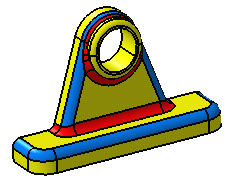You can detect rounds and fillets by setting
single radius values.
Click Part Analysis
 in the Part Design Feature Recognition toolbar.
in the Part Design Feature Recognition toolbar.
The Part Analysis dialog box appears.
It is divided into two areas: the left one is dedicated to rounds
analysis, the right one to fillets analysis.
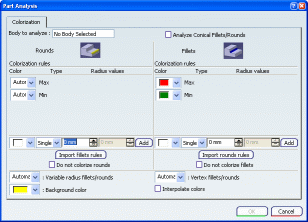
Select Body.1 as the body of which fillets and rounds you
want to see. You can select it either by clicking on a node of the
specification tree, or by selecting one of its face, edge or vertex in
the geometry area. Note that only one body can be analyzed at a time.
Body.1 is now displayed in the Body to analyze box.
You are going to detect the number of rounds and
fillets which radius value is 8mm in your 3D shape. For that, first you need
to add colorization rules . At the bottom of the
Colorization rules frame,
there is a rule you can define and then add. For the single value rule,
keep the rule type option as Single.
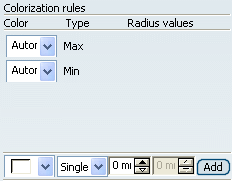
To the left of Single, click the color combo
box.
A list appears containing:
-
a blank color box
-
a list of default colors from the color palette,
ready for use
-
the More Colors... option
For example select the blue color. This is the color
chosen for showing all rounds of the 3D shape with 0mm as radius value.
The selected color is now displayed in the box in the combo box.
Pointing the cursor over the combo box displays the name of the selected
color.
Enter 8 in the radius box next to the Singlecombo box.
Click Add to validate and add the rule.
The
Rounds frame now looks like this:
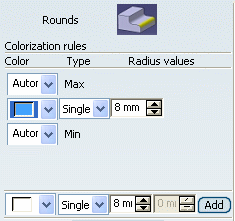
Note that:
The rules will be added in the order of sorting. So
even if you change the radius value for the rule, it may get rearranged
in the sorting order.
-
The rule can be deactivated by setting its color as
Automatic.
-
All colorization rules and colors for other options are
saved (only when you click OK to close the dialog box) and
are restored when you launch the capability again.
Repeat the previous operations for fillets, just choose a
distinct color to identify them. Red, for example.
The Fillets frame now looks like this:
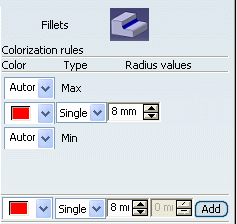
Set the yellow color as the background color. This means
that all the faces of the selected body that do not follow any rule are
colored in yellow.

Once done, click OK to compute the results.
An informative window appears, detailing the number and the composition
of detected rounds and fillets.
Click OK to close the informative window.
The result now appears. 8 rounds identified by the blue
color and 5 fillets identified by the red color, which radius values are
8mm were recognized.
